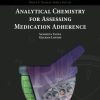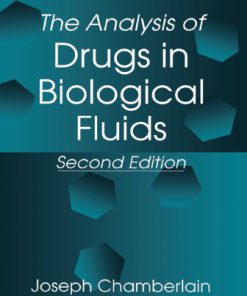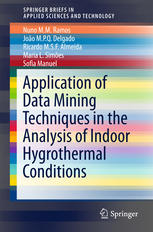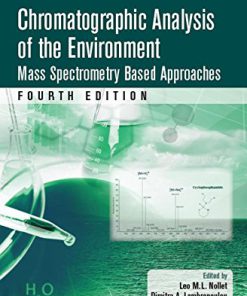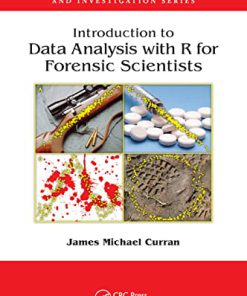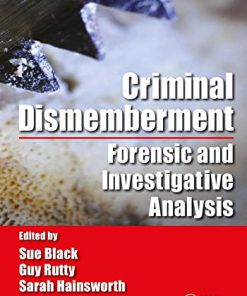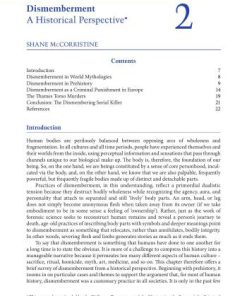Chromatographic Techniques in the Forensic Analysis of Designer Drugs 1st Edition by Teresa Kowalska, Mieczyslaw Sajewicz, Joseph Sherma 1138033286 9781138033283
$50.00 Original price was: $50.00.$25.00Current price is: $25.00.
Chromatographic Techniques in the Forensic Analysis of Designer Drugs 1st Edition by Teresa Kowalska, Mieczyslaw Sajewicz, Joseph Sherma – Ebook PDF Instant Download/DeliveryISBN: 1138033286, 9781138033283
Full download Chromatographic Techniques in the Forensic Analysis of Designer Drugs 1st Edition after payment.
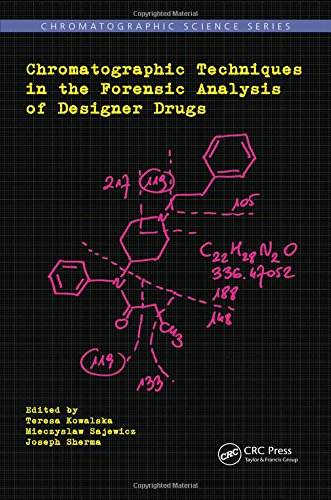
Product details:
ISBN-10 : 1138033286
ISBN-13 : 9781138033283
Author: Teresa Kowalska, Mieczyslaw Sajewicz, Joseph Sherma
There is a dramatic rise of novel drug use due to the increased popularity of so-called designer drugs. These synthetic drugs can be illegal in some countries, but legal in others and novel compounds unknown to drug chemistry emerge monthly. This thoughtfully constructed edited reference presents the main chromatographic methodologies and strategies used to discover and analyze novel designer drugs contained in diverse biological materials. The methods are based on molecular characteristics of the drugs belonging to each individual class of compounds, so it will be clear how the current methods are adaptable to future new drugs that appear in the market.
Chromatographic Techniques in the Forensic Analysis of Designer Drugs 1st Table of contents:
Section I
Chapter 1 Introduction
1.1 Designer Drugs: Historical Background and Present Status
1.2 Contents of the Book
References
Chapter 2 Designer DrugsLegislating for Tomorrow Through the Use of Class Definitions and Pharmacophore Principles
2.1 Introduction
2.2 Federal Legislation
2.3 State Laws
2.4 Class Definitions and Pharmacophores
2.5 Conclusion
References
Chapter 3 Alternative Legislation with Designer Drugs
3.1 Introduction
3.2 The Individual Drug Listing System
3.3 The Generic Approach
3.4 The Medicinal Product Approach
3.5 Conclusions
References
Chapter 4 Biological Background of Designer Drugs
4.1 Introduction
4.2 Neurotransmitters
4.2.1 Drug Chemistry and Action
4.2.2 Addiction
4.3 Alkaloids as Plant Metabolites
4.4 Adenosine
4.5 Opioids
4.6 Cannabinoids
4.7 Serotonin
4.7.1 Tryptamines
4.7.2 Ergot Alkaloid Derivatives
4.8 Amino Acids
4.8.1 Benzodiazepines
4.8.2 Ketamine and Phencyclidine Analogs
4.9 Acetylcholine
4.10 Dopamine
4.10.1 Ephedrine
4.10.2 Cathinones
4.10.3 Amphetamines
4.10.4 Designer Modifications of Phenylethylamine Derivatives
4.10.5 Piperazines
4.10.6 Cocaine
4.11 Steroids
References
Chapter 5 Liquid Chromatography–Mass Spectrometry in the Analysis of Designer Drugs
5.1 Introduction
5.1.1 Color Tests
5.1.2 Immunoassays
5.1.3 Prominent MS Techniques in Screening, Identification, and Confirmation
5.1.4 Multitechniques in Designer Drug Analysis
5.2 LC-MS/MS Analysis of NPSs
5.2.1 Short Glance at LC-MS/MS
5.2.2 Triple Quadrupole LC-MS/MS
5.2.3 Most Used LC-HR-MS Techniques in the Analysis of NPSs
5.2.3.1 Ion Trap MS
5.2.3.2 TOF-MS
5.2.4 Which Matrix, for Which Aim?
5.2.5 Metabolism Studies with LC-MS/MS and Isomer Analysis
5.2.6 Hair Analysis in the Determination of Acute and Chronic Consumption
5.2.7 Oral Fluid as an Easily Collected and Confident Sample
5.2.8 Selected Studies in Different Matrices and with Different Extraction Techniques
5.2.9 Sample Studies with Multitechniques in the Screening, Identification, and Confirmation of NPSs
5.2.10 Remarks on Validation with LC-MS/MS
5.3 Conclusions and Future Prospects
Glossary
References
Chapter 6 Ambient Plasma Ionization Techniques in Forensic Analysis
6.1 Introduction
6.2 Applications
6.3 DART—Direct Analysis in Real Time
6.4 Other Ambient Plasma Ionization Techniques
6.5 Conclusions
References
Chapter 7 Application of LC-QTOFMS for the Identification of the Structure of New Psychoactive Substances
7.1 Characterization of Quadrupole Time-of-Flight Mass Spectrometry
7.2 Challenges in Identification of Structures of New Psychoactive Substances
7.3 Procedures Used in Identification of New Psychoactive Substances by LC-QTOFMS
7.4 LC-QTOFMS for Analysis of Seized Samples Containing New Psychoactive Substances
7.5 LC-QTOFMS Identification of Novel Substances in Biological Material
7.6 Summary
Acronyms of Chemicals Used in the Chapter
References
Chapter 8 Rapid Generation of Metabolites by Electrochemical Method
8.1 Introduction
8.2 Materials and Methods
8.2.1 Chemicals
8.2.2 Incubation of XLR-11 with Microsomes
8.2.3 Electrochemical Oxidation of XLR-11
8.3 Results
8.3.1 Natural Metabolites of XLR-11
8.3.2 Oxidation Products of XLR-11
8.4 Conclusions
8.5 Summary
Acknowledgments
References
Chapter 9 Gas Chromatography–Mass Spectrometry in the Analysis of Designer Drugs
9.1 Introduction
9.2 Gas Chromatography–Mass Spectrometry (GC-MS) in Forensic Drug Analysis
9.3 Application of GC-MS in the Analysis of Designer Drugs
9.3.1 Analysis of Synthetic Cathinones
9.3.2 Analysis of Synthetic Cannabinoids
9.4 Derivatization in the Identification of Designer Drugs
9.5 Retention Time Locking (RTL) as an Analytical Tool in Identification of Isomers
9.6 Thermal Degradation of Designer Drugs as a Common Problem in the Analysis of Designer Drugs by GC-MS
9.7 Summary
References
Chapter 10 NMR Spectroscopy in the Analysis of Illegal Drugs
10.1 Introduction
10.2 Hyphenated Techniques
10.3 1D and 2D NMR Spectroscopy
10.4 Routine Methods of 2D NMR Spectroscopy
10.5 Selected Examples of the NMR Analysis of Illegal Drugs
10.5.1 Acetic Acid Anhydride (AA) as a Precursor of Illicit Narcotic and Psychotropic Drugs
10.5.2 Illegal Production of Amphetamine
10.5.3 Synthetic Cannabinoids
10.5.4 Fake Antitetanus Vaccine
10.5.5 SatiboTM Capsules for the Treatment of Erectile Dysfunction
10.5.6 Green Coffee for Slimming
10.6 Conclusion
Acknowledgments
References
Chapter 11 Preparation of Biological Material for Toxicological Analysis
11.1 Introduction
11.2 Applications
11.2.1 Screening Analysis of Biological Material
11.2.2 Blood and Urine Liquid–Liquid Extraction
11.2.3 Blood and Urine Solid Phase Extraction
11.2.4 Extraction of Internal Organs
11.2.5 Hair Preparation for Toxicological Analysis
11.2.6 QuEChERS Technique in the Preparation of Biological Material for Toxicological Analysis
References
Chapter 12 Discrimination among Designer Drug Isomers by Chromatographic and Spectrometric Methods
12.1 Isomers and Isomerism
12.2 Significance of Drug Isomerism
12.3 Isomers of Designer Drugs
12.4 Discrimination among Designer Drug Isomers by Various Techniques
12.4.1 Isomers Discrimination by GC-MS
12.4.2 Discrimination by HPLC-DAD
12.4.3 Discrimination by LC-MS
12.4.4 Discrimination by Other Methods
12.5 Conclusions
References
Section II
Chapter 13 Mass Spectrometric Analysis Applied for the Determination of Synthetic Cannabinoids
13.1 Introduction
13.2 Gas Chromatography–Mass Spectrometry (GC-MS)
13.2.1 Identification of Synthetic Cannabinoids
13.2.2 Sample Preparation for GC-MS
13.2.3 Applications of GC-MS
13.2.4 Pitfalls
13.3 Liquid Chromatography–Mass Spectrometry (LC-MS)
13.3.1 Identification of Synthetic Cannabinoids by Tandem MS
13.3.2 Identification of Synthetic Cannabinoids by High-Resolution MS
13.3.3 Sample Preparation for LC-MS
13.3.4 Applications of LC-MS
13.3.5 Pitfalls
13.4 Future Prospects
Abbreviations
References
Chapter 14 Cathinone Derivatives and Their Analysis
14.1 Introduction
14.1.1 Short History of the Appearance of Cathinone and Evolution of its Derivatives
14.1.2 Chemistry of Cathinone Derivatives
14.1.3 Metabolism and Mechanism of Action of Cathinones
14.2 Applications
14.2.1 Trends in the Modification of Cathinone Structures and Characterization Thereof
14.2.2 Analytical Techniques of Identification of Cathinones
14.2.2.1 Screening Techniques in the Analysis of Biological and Non-Biological Materials
14.2.2.2 Gas Chromatography Coupled with Mass Spectroscopy (GC-MS)
14.2.2.3 Liquid Chromatography Coupled with Mass Spectroscopy (LC-MS)
14.2.2.4 Liquid Chromatography Coupled with UV-Vis, NMR, and IR Spectroscopy
References
Chapter 15 2C Derivatives of Phenylethylamines and Their Analysis
15.1 Introduction
15.1.1 2C-I Analog
15.1.2 2C-B Analog
15.1.3 Other 2-C Analogs and the D-Series
15.1.4 Availability, Symptoms, Routes of Use, Pharmacology, and Pharmacokinetics
15.1.5 Metabolism
15.2 Analysis of 2C Derivatives
15.2.1 Immunoassay Analysis
15.2.2 GC-MS
15.2.3 Capillary Electrophoresis (CE)
15.2.4 LC-MS and LC-MS/MS
15.2.5 Discrimination and Identification of Isobaric Compounds
15.2.6 Impurity Analysis
15.2.7 Collaboration of Clinical and Analytical Methods in Diagnosis of Intoxication
15.2.8 Wide-Scope Screening and Confirmation
15.2.9 Computational Chemistry Providing Data for Analytical Use
15.2.10 Metabolism Studies/Metabolite Analysis
15.2.11 Use of Multimethods
15.3 Future Prospects
References
Chapter 16 NBOMe Derivatives of Phenylethylamines and Their Analysis
16.1 Introduction
16.1.1 Pharmacological and Toxicological Effects and Doses
16.1.2 New NBOMe Analogs
16.2 Analysis of NBOMe Derivatives
16.2.1 An Overview of Techniques Used for Screening and Identification
16.2.2 GC-MS Analysis of NBOMe Derivatives
16.2.3 Analysis of NBOH Compounds
16.2.4 LC-MS/MS Analysis of NBOMe Derivatives
16.2.5 Metabolism Studies/Metabolite Identification
16.2.6 Has the User Really Taken the Compound on the Label?
16.2.7 Multimethods for Identification: An Effective Tool in the Characterization of New Analogs
16.2.8 Determination and Discrimination of Close Analogs and Positional Isomers
16.3 Conclusions
References
Chapter 17 Forensic Analysis of Piperazines
17.1 Introduction to Piperazines
17.2 Manufacture of Piperazines
17.3 Legal Status and Control of Piperazines
17.4 Analytical Schemes for Piperazines
17.5 Physical Description of Piperazines
17.6 Presumptive Tests
17.7 Instrumental Analysis of Piperazines
17.7.1 Extraction of Piperazines from Street Samples
17.7.2 Thin-Layer Chromatography
17.7.3 Liquid Chromatographic Methods
17.7.4 Gas Chromatographic Methods
17.7.5 Capillary Zone Electrophoresis
17.8 Spectroscopic Methods
17.9 Conclusions
References
Chapter 18 Chromatographic Analysis of Fentanyl and Its Analogs
18.1 Introduction
18.2 Fentanyl and Analogs
18.3 Gas Chromatography
18.4 Liquid Chromatography
18.4.1 HPLC
18.4.2 LC-MS
18.4.3 LC-MS/MS
18.4.4 LC-HRAMS
18.5 Future Perspectives
References
Chapter 19 Modern Techniques for the Identification of Tryptamines
19.1 Characterization of Tryptamine-Type ?Designer Drugs
19.2 Identification of Tryptamines by GC-MS
19.2.1 Chromatographic Data
19.2.2 Analysis of Fragmentation under EI
19.3 Liquid Chromatography with Different Detectors Used for Identification of Tryptamines
19.3.1 High-Performance Liquid Chromatography with Diode-Array Detection
19.3.2 Identification of Tryptamines by LC-QTOFMS
19.4 Other Analytical Methods Used in Identification of Tryptamines
19.4.1 Capillary Electrophoresis
19.4.2 Miscellaneous Methods
Acknowledgments
References
Chapter 20 Toxicological Analysis of New Opioids
20.1 Introduction
20.2 Novel Opioid Designers
20.3 Methods of Forensic Analysis of Designer Opioids—Preliminary Methods for Opioid Detection
20.4 Isolation and Analysis Methods of Opioids from Biological Samples
20.5 Analysis Methods of Metabolic Opioids
20.6 Conclusions
References
Chapter 21 Toxicological Analysis of Designer Benzodiazepines
21.1 Introduction
21.2 Benzodiazepines as New Psychoactive Substances (NPSs)
21.3 Analysis of Seized Material
21.4 Methods of Forensic Analysis of Designer Benzodiazepines
21.5 Conclusions
References
Chapter 22 Thin-Layer Chromatography in the Analysis of Designer Drugs
22.1 Introduction
22.2 Applications
22.2.1 Analysis of Biological Samples for Designer Drugs
22.2.2 Detection and Identification of Designer Drugs
22.2.3 Determination of Drugs That Are Naturally Present or Are Added to Herbal Samples
22.2.4 Chiral Determination of Designer Drugs
22.2.5 Quantification of MDMA in Seized Tablets
22.2.6 Coupling of TLC and Fourier-Transform (FT) IR Spectrometry for Analysis of Amphetamine-Type Designer Drugs
22.2.7 Online TLC-MS Analyses
22.2.8 Isolation of Designer Drugs by PLC for Their Identification
22.3 Future Prospects
People also search for Chromatographic Techniques in the Forensic Analysis of Designer Drugs 1st:
classification of chromatographic techniques
types of chromatographic techniques
non chromatographic techniques
purification by chromatographic techniques
different types of chromatographic techniques
Tags: Chromatographic Techniques, the Forensic Analysis, Designer Drugs, Teresa Kowalska, Mieczyslaw Sajewicz, Joseph Sherma
You may also like…
Science (General)
Engineering
Forensic Science
Computers - Networking
Data Analysis in the Cloud : Models, Techniques and Applications 1st Edition Marozzo
Politics & Philosophy - Social Sciences



